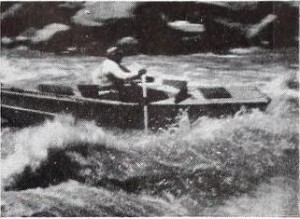
"Grand Canyon Voyage is the record of how seven daring people in three tiny boats ran the Colorado River from Lee's Ferry in Arizona, through the awesome gorge of the Grand Canyon, to Lake Mead in Nevada. The trip itself was the exciting and gallant climax to four years of dedicated effort by Al Morton. Ideally, this film record of the trip should be infused with this same excitement, this same sense of gallant adventure. That it is not consistently so inspirited will be a source of sincere regret to all who know Mr. Morton. But perhaps no motion picture of this dangerous, demanding river run could recreate this spiritual overtone. The physical odds against filming were too great, too overwhelming, for controlled camera work and integrated continuity. Survival itself became more important than an image of it. Al Morton, we believe, has done a supremely difficult job far better than would the most of us. He has done it as well, surely, as any cameraman living." Movie Makers, Dec. 1951, 411.
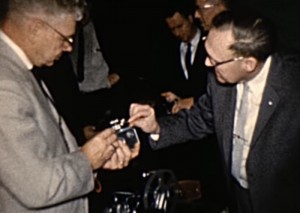
The G.R.A.M.C. holds an open house on November 1, 1961. This film documents the event, showing amateur filmmakers dining, conversing with one another, and examining cameras.
"Among the films awarded honorable mention is The Grand Teton Country, carrying with it a breadth and sweep of all outdoors, a Kodacolor film by H. W. Voss, ACL. This picture is, first of all, an eloquent and colorful reply to those who do not believe that long shots can be taken successfully by this process. Time and again, in viewing this film, one is astonished by the clarity and detail of distant mountains, rearing their majestic, snow capped heads up into the cold blue of the sky, while the foreground is shown in all of its true colors. Mr. Voss has proved to skeptical Easterners that Rainbow Falls really lives up to its name. His Kodacolor camera, skillfully handled so as to produce a dark background for the rainbow formed by the sun shining on the spray, reveals perfectly that faint, tenuous beauty which is all the more remembered because evanescent. But solid, palpable colors are pictured here, too. Mountains and canyons, lakes that are mirrors, desert flowers and all the glowing colors that are part of the West, are arranged on Mr. Voss's film palette. Especially well considered was his continued use of the various neutral density filters in order to give distant shots their correct value in the brilliant sun and the inclusion of interesting action in each scene." Movie Makers, Dec. 1932, 560-561.
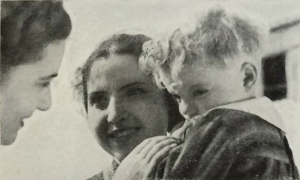
"a sogg. lungh. norm." Feature fiction film
"La grande casa, realizzato da Guido Pallaro, Cesco Cocco, Fernando de Marzi, soggetto di Giulio Fracarro, operatore Antonio Schiavinotto, interpreti Livia Lauri, Otello Toso, Lia Zanolla, Ario Chiarin, Luisa Sironi, aiuto Giorgio Pomerri. II film prodotto dalla Sezione Cinematografica del GUF di Padova che nelle prove precedenti ha dimostrato di possedere un buon numero di elementi volonterosi e di sicure possibilità, risente nel suo complesso della bontà della organizzazione; e questo un elemento da tener presente, perché mostra che ove alla buona organizzazione si venga ad aggiungere una piu persuasiva forza artistica, il gruppo Padovano potrà raggiungere risultati cospicui. Il difetto della Grande Casa sta appunto nella mancanza di forza interiore. Il tema prescelto, la costruzione della Casa dell'assistenza, non è stato svolto in uno scenario organico e provvisto di elementi atti a permettere una realizzazione più serrata e convincente; invece la narrazione è un po' preoccupata, lenta e dispersiva. Comunque il film non manca di momenti felici, di qualche buona descrizione ambientale, di sobrietà interpretativa; cosi pure l'assenza di retorica e un elemento da non trascurarsi e che torna a vantaggio della produzione."
"The Great House (La grande casa), by Guido Pallaro, Cesco Cocco, Fernando de Marzi, subject by Giulio Fracarro, cameraman Antonio Schiavinotto, actors Livia Lauri, Otello Toso, Lia Zanolla, Ario Chiarin, Luisa Sironi, assistant Giorgio Pomerri. The film produced by the Padua GUF Cinematographic Section, which in previous tests has demonstrated that it possesses a good number of willing elements and certain possibilities, suffers in its entirety from the virtue of the organization; and this is an element to keep in mind, because it shows that where good organization is added to a more persuasive artistic force, the Paduan group can achieve significant results. The defect of The Great House is precisely in its lack of inner strength. The theme chosen, the construction of the House of assistance, was not carried out in an organic scenario nor was it provisioned with elements to allow a more tight and convincing direction; instead the narrative is a little worried, slow and scattered. However, the film does not lack apt moments, of some good environmental description, of interpretative sobriety; so also the absence of rhetoric is an element not to be neglected and that returns to the advantage of the production."
—Il ventuno 28 (Review of the G.U.F. of Venice), May 1935
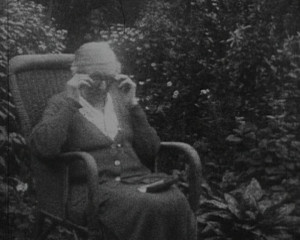
"Amateur filmmaker, cinema historian and railway engineer H.A.V. Bulleid uses slapstick humour and witty intertitles in this farce.When the family dogs team up to steal and bury Grandma's glasses, they spark a farcical chain of events in which our hapless hero attempts to track down the missing spectacles. But even when the glasses 'turn up', the ordeal isn't over as they get stuck up a tree and switched with a bomb. And in the end, it's sure to be the dogs who have the last laugh" (EAFA Database).
"Grandmother's Portrait is a documentary on the making of a modernistic, even abstract, metal "portrait" inspired by a photograph of the artist's grandmother. The artist doing the sawing and welding needed to construct the "portrait" is Kasperi Lofgren" PSA Journal, Sept. 1965, 50.
"Bathers enjoy the sun and sea air at the popular saltwater lido at Grange-over-Sands, on the Cumbrian coast overlooking Morecambe Bay. Stylishly designed by the council's surveyor Bernard Smith, the Art Deco lido, with its mushroom shaped pool, opened in 1932. It soon proved to be massively popular with swimmers and spectators alike, in keeping with the 1930s vogue for healthy outdoor activities." (BFI Player)
"Family scenes in the garden at Greenbank, Keswick - the children dance, do somersaults, skip and perform for parents and grandparents." (NWFA Online Database)
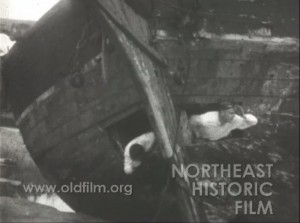
"Amateur stage play directed by Roger Clapp and starring Dorothy Stebbins." Northeast Historic Film.
Total Pages: 299